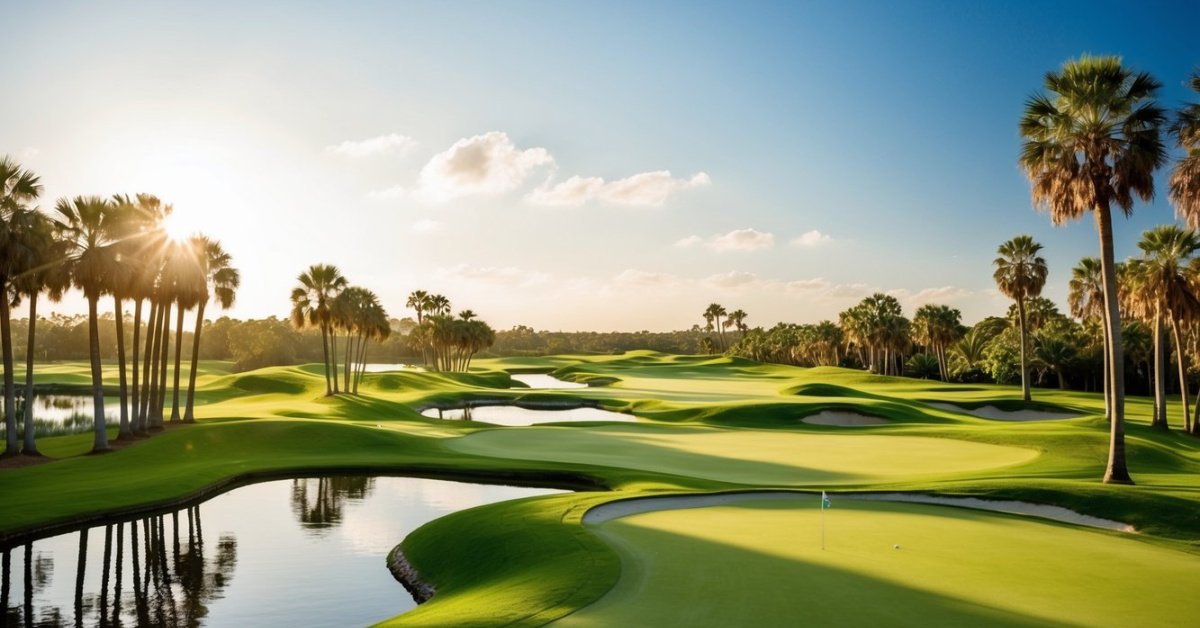Ever wondered what makes a golf ball the “best”? With so many options on the market, it’s tough to know which one will shave strokes off your game. But don’t worry, you’re about to discover the cream of the crop.

We’ll dive into what sets top-tier golf balls apart, from materials to dimple patterns. Whether you’re a seasoned pro or just starting out, finding the right golf ball can be a game-changer.
What Makes a Golf Ball the Best?
When you’re on the course, the golf ball you choose becomes an extension of your playing style. But you might wonder, what sets a great golf ball apart from the rest?
Spin rates, feel, and control are at the heart of a top-tier golf ball. A high-spin ball can provide better control around the greens, letting you shape shots and stop the ball on a dime. But it’s not just about spin; the compression of a ball affects how it reacts upon impact. Lower compression golf balls tend to be softer, allowing you to compress the ball on tee shots for maximum distance.
Let’s not forget the cover of the ball.
- Urethane-covered balls tend to offer higher spin rates and feel softer.
- Surlyn covers are more durable and provide a lower spin, which might suit your straight-shooting game better.
And then there’s the dimple pattern. It’s what defines the aerodynamics of the ball. Diverse patterns affect how the air flows around the ball, influencing distance and stability in windy conditions.
| Factor | Low Compression | High Compression |
|---|---|---|
| Spin | Lower | Higher |
| Durability | Less | More |
| Feel | Softer | Firmer |
Choosing a ball with the right balance of these characteristics is crucial. If you’re a golfer with a high swing speed, you’ll need a ball that can handle that power without losing shape. For slower swingers, a ball with lower compression can add yards to your drive with the same swing effort.
Remember, it’s your game and your choice. Test different balls to see which one responds to your swing the best. After all, the best golf ball is the one that helps you perform your best on the course.
Materials Matter
When you’re scouring the market for that perfect golf ball, it’s not just spin rates, cover types, or dimple patterns that should be catching your eye. The very materials that make up the ball are fundamental to its performance.
« How to Stop a Golf Ball from Hooking: Swing Adjustments for Straighter Shots
Should I Look at the Golf Ball? Unlock the Secret to Perfect Shots »
Picture this: you’re stepping up to tee off and your choice in golf ball could be the key to that extra bit of distance or precision. The core material often dictates the compression and, in turn, the potential energy transfer from your club to the ball. For you as a low handicapper, a golf ball with a multi-material construction could provide a dual benefit—a soft core for feel and a firmer outer layer for speed.
Let’s talk about the mantle, the layer just beneath the cover. If it’s integrated well with a high-quality core, you’ll experience a better energy transfer. Golf balls boasting a high-modulus ionomer mantle can mean the difference between a ball that just flies and one that flies with purpose toward the green.
Your focus on short game nuances demands a cover material that’s receptive to your skilled shot-making. Urethane covers are typically associated with premium golf balls, delivering that soft feel and high spin control around the greens. You’re more likely to shape your shots and execute precise stops on fast greens with urethane. On the contrary, Surlyn covers are hardier, providing more resilience to cuts and scuffs, which might be a secondary consideration if you value durability alongside performance.
- A multi-layer core can optimize distance and control
- High-modulus ionomer mantles provide targeted energy transfer
- Urethane covers yield delicate control for the finesse player
- Surlyn covers offer durability for the practical golfer
The takeaway here is clear: don’t just pick a golf ball off the shelf. Look deeper into what it’s made of, and how those materials are put together. Your game deserves that level of attention, and when you find the right ball, you’ll feel the difference on every swing. Now, let’s dive deeper and think about how the manufacturing process influences the layering and performance of these advanced golf balls.
The Importance of Dimple Patterns
When you’re on the hunt for the best golf ball, you can’t overlook the dimple pattern. These small indentations on the ball’s surface might seem trivial, yet they’re crucial for your game’s aerodynamics. The patterns affect flight stability, distance, and the overall trajectory of the ball.
Golf ball dimple patterns are not just random designs; they are a feat of engineering. Manufacturers experiment with different shapes, sizes, and numbers of dimples to enhance performance. The primary purpose is to reduce air resistance and influence lift. It’s the dimples that allow a golf ball to travel farther than a smooth sphere would.
Consider this – a smoother ball would have a high drag coefficient, causing it to slow down rapidly in flight. On the other hand, a dimpled ball creates a thin layer of air around the surface which helps in reducing drag. This layer helps keep the ball in flight longer, resulting in that extra yardage we all crave.
Not all dimple patterns are created equal. Some are designed for high launch angles with low spin rates, while others cater to players seeking a more penetrating ball flight. You might come across:
- Standard patterns, where the dimples are uniformly sized and spaced
- Mixed patterns, combining different sizes for a more customized flight path
When choosing a golf ball, think about your swing speed and desired ball flight characteristics. A ball with fewer, deeper dimples could provide more distance for a slow swinger, while a high-speed swinger might benefit from a higher dimple count which offers more control and a lower trajectory.
Next time you’re picking out a ball, don’t just go for the brand or price tag. Give those little dimples the attention they deserve. They could be the game-changer in your next round, helping you achieve the precise aerodynamics suited to your swing. So, examine the dimple pattern and consider how it aligns with the rest of the golf ball’s features on your journey to optimize your game.
Finding the Right Golf Ball for Your Game
Choosing a golf ball that meshes well with your playstyle is crucial. You’ve got your swing down. Now, it’s about complementing it with a ball that responds to your game. When you ponder your next purchase, think beyond brand names or what your golf buddies are using—consider what will aid your specific skills on the links.
Begin by assessing your swing speed. It’s a pivotal factor that determines the golf ball’s performance in your hands. High swing speeds can compress high-compression golf balls, maximizing energy transfer for longer flights. On the flip side, if your swing speed isn’t breaking any records, low-compression balls could be your ticket to a better distance.
Next, let’s talk about feel. It’s subjective but vital. Feel influences your control on shots around the green and while putting. Do you prefer a soft feel that allows for delicate drop-and-stop action on the greens? Or maybe you lean towards a firmer feel for a better feedback when you strike the ball? It’s your call—and it can change everything from your confidence to your scoring.
Spin characteristics need your attention too. High-spin balls might give you more control and stopping power on the green, which can be a godsend, especially if you’re playing on fast greens or trying to navigate tough pins. However, if you’re battling a hook or a slice, a lower-spin ball might help mitigate side spin, resulting in straighter shots.
Here are a few guidelines to help you narrow down your choices:
- High Handicapper? Opt for balls that promise distance and durability.
- Mid Handicapper? Look for a balance between distance and spin control.
- Low Handicapper? Prioritize spin, feel, and controllability.
Remember that weather conditions also play a role in your decision. Soft-cover balls can perform better on cold days, as they stay more pliable. Conversely, during scorching summer rounds, a harder ball might maintain its shape and performance level better.
Lastly, don’t underestimate the importance of a golf ball fitting session. Yes, just like clubs, your ball can be fit to your game. A professional fitting can reveal surprising insights and help you make an informed choice that’ll shave strokes off your game. Swing by your local pro shop or fitting center and see what you might have been missing out on.
Conclusion
Frequently Asked Questions
What determines the “best” golf ball?
The best golf ball is determined by factors like spin rates, feel, control, and compression. These elements affect performance and match a golfer’s individual style.
How do the materials of a golf ball impact its performance?
Materials impact a golf ball’s energy transfer, distance, spin control, and durability. The core, mantle, and cover each play a role in how the ball behaves on the course.
Why are dimple patterns important on a golf ball?
Dimple patterns affect flight stability, distance, and trajectory by reducing air resistance and influencing lift. They’re tailored for specific launch angles and spin rates.
Should I choose a golf ball based on my swing speed?
Yes, selecting a golf ball that matches your swing speed can improve your control and maximize distance. Your desired ball flight characteristics also play a role in selecting the right dimple pattern.
How can my playstyle influence the type of golf ball I choose?
Your playstyle dictates the ball’s feel and spin characteristics you may prefer. Golf balls should complement your swing speed, handicap, and typical playing conditions.
Is a golf ball fitting session important?
A golf ball fitting session is important to make an informed choice as it considers your unique swing and playing style, accounting for various factors such as swing speed and ball flight preferences.










